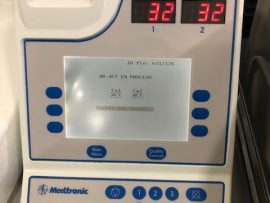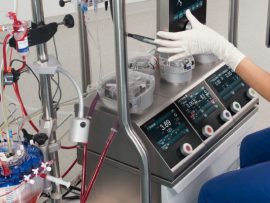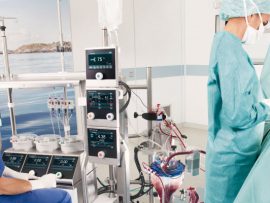Abstract OBJECTIVES Cardiopulmonary bypass in cardiac surgery has been associated with several deleterious effects including haemodilution and systemic inflammation. Modified ultrafiltration (MUF) has been well established in paediatric cardiac..
Read MoreAbstract Objective To compare the incidence and severity of acute kidney injury following open heart surgery with cardiopulmonary bypass in children after administration of exogenous nitric oxide. Design Retrospective cohort..
Read MoreAbstract Introduction: The Activated Clotting Time (ACT) is commonly used to manage anticoagulation during cardiac surgery. The aim of this study was to compare the older manually operated Hemochron® Response and..
Read MoreAbstract There is limited evidence as to the pharmacokinetic changes expected in adults with extracorporeal technologies. Drugs may be taken up by various components of the cardiopulmonary bypass circuit itself...
Read MoreAbstract OBJECTIVES: Cardiopulmonary bypass triggers systemic inflammation, resulting in lung injury, and frequently leads to prolonged mechanical ventilation. Biomarkers of systemic inflammation are required to predict the risk of such..
Read MoreAbstract Objectives: Soluble MER has emerged as a potential biomarker for delayed resolution of inflammation after myocardial injury and a therapeutic target to reduce cardiac-related morbidity and mortality in adults...
Read MoreAbstract Introduction: A high-pressure excursion (HPE) is a sudden increase in oxygenator inlet pressure during cardiopulmonary bypass (CPB). The aims of this study were to identify factors associated with HPE,..
Read MoreAbstract Background: Acute kidney injury (AKI) is a common and serious complication faced by children following ventricular septal defect (VSD) surgery with cardiopulmonary bypass (CPB). The objective of this study was..
Read MoreAbstract Background: Cardiac surgery–associated acute kidney injury (AKI) is an adverse outcome that increases morbidity and mortality in patients undergoing cardiac surgical procedures. To date, the use of serum creatinine..
Read MoreAbstract Dexmedetomidine (DEX) is a sedative used in combination with other drugs in neonates and infants undergoing cardiac surgery using cardiopulmonary bypass (CPB). This study aimed to evaluate the disposition..
Read MoreAbstract Background Guidelines recommend evaluation for electrographic seizures in neonates and children at risk, including after cardiopulmonary bypass (CPB). Although initial research using screening electroencephalograms (EEGs) in infants after CPB..
Read MoreAbstract Aim Renal tissue hypoxia during cardiopulmonary bypass could contribute to the pathophysiology of acute kidney injury. We tested whether renal tissue hypoxia can be alleviated during cardiopulmonary bypass by..
Read MoreAbstract Background Three-dimensional printing is a process enabling computer-assisted conversion of imaging data from patients into physical “printed” replicas. This has been extrapolated to reconstructing patient-specific cardiac models in . The..
Read MoreAbstract Objectives: The aim of this study is to evaluate the safety and efficacy of the novel bidirectional cannula that ensures stable distal perfusion compared to conventional cannula in patients..
Read MoreAbstract Purpose: The potential cardio-protective property of germinated brown rice (GBR) has been revealed by ameliorating risk factors related to cardiovascular diseases. This study hypothesized that the combination of GBR and..
Read MoreAbstract Introduction Novel biomarkers of acute kidney injury (AKI) are being developed and commercialized. However, none are universally available. The aim of this preliminary prospective observational study was to explore the..
Read MoreObjectives Blood-processing techniques and preservation conditions cause storage lesions, possibly leading to adverse outcomes after transfusion. The authors investigated the metabolic changes and deformability of red blood cells (RBCs) during..
Read MoreAbstract 71.759 surgical procedures were performed in 2019 with the aid of cardiopulmonary bypass in Germany. To adjust the patient’s body temperature on extracorporeal circulation, the application of a heater-cooler..
Read MoreAbstract Objectives: To describe blood component usage in transfused children with congenital heart disease undergoing cardiopulmonary bypass surgery across perioperative settings and diagnostic categories. Design: Datasets from U.S. hospitals participating..
Read MoreAbstract Objective: This study aims to investigate the effect of optimized ultrafiltration on perioperative electrolytes, acid–base balance, and pulmonary function during cardiopulmonary bypass (CPB) in infants with low body weight (under..
Read MoreAbstract Objectives Recombinant factor VIIa is used off-label for refractory bleeding after cardiac surgery. This study reviewed the indications, usage rates and complications of recombinant factor VIIa. Design Retrospective case..
Read MoreAbstract Objectives To assess the ability of the biomarkers neuron-specific enolase (NSE), tau, neurofilament light chain (NFL), and glial fibrillary acidic protein (GFAP) to predict postoperative cognitive dysfunction (POCD) at..
Read MoreAbstract Background The American College of Surgeons Committee on Trauma requires that all level I trauma centers have cardiopulmonary bypass (CPB) capabilities immediately available. Despite this mandate, there is limited..
Read MoreAbstract Blood-primed cardiopulmonary bypass circuits are frequently necessary to achieve safe support during pediatric open-heart surgery. Literature is lacking regarding suitable prime constituents or methods for achieving a physiologically appropriate..
Read MoreAbstract OBJECTIVES Management of resternotomy is often a difficult challenge in patients with congenital diseases who have undergone multiple sternotomies. Our goal was to report our single-centre experience with carotid..
Read MoreAbstract BLEEDING is a well-documented and frequently encountered complication after cardiac surgery, affecting roughly 2%-to-10% of all patients. Major bleeding is a known risk factor for significant morbidity and mortality..
Read MoreAbstract Introduction: Despite extensive evidence that shows clinical of superiority of MiECC, worldwide penetration remains low due to concerns regarding air handling and volume management in the context of a..
Read MoreAbstract Objectives The objective of this study was to identify novel serum biomarkers specific to postoperative delirium after major cardiac surgery to provide insight into the pathologic processes involved in..
Read MoreAbstract The use of cardiopulmonary bypass (CPB) can be associated with significant hemodilution, coagulopathy and a systemic inflammatory response for infants and children undergoing cardiac surgery. Intra-operative ultrafiltration has been..
Read More














